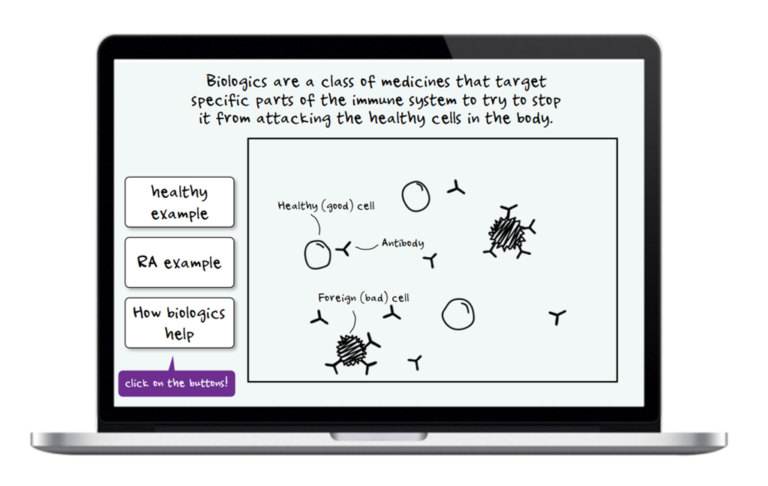PATIENT PREFERENCE SURVEY: RHEUMATOID ARTHRITIS
Interactive training materials to enable the elicitation of the preferences of public and the patients about new stratified approaches to prescribing biologics for rheumatoid arthritis.
In short: A clinical trial was performed to capture patient preferences about treatment with biologics for rheumatoid arthritis. Patients received information about the disease/treatment options and choice task at hand, either by a text-based explanation or MindBytes’ interactive educational tool (created using EDU-GRID).
Results showed that our animated training materials did not change the preferences of patients, but improved choice consistency. This could allow researchers in the future to include more complex study designs with increased numbers of attributes, levels, alternatives or choice sets.
Want to know more? Together with researchers based at The University of Manchester, we created an interactive educational component using a narrative storyline, (‘training materials’) to be embedded within a survey that asked respondents to complete a Discrete Choice Experiment (DCE). The objective of training materials in DCEs is to inform the sample of respondents (general public and patients) about the questions being asked in such a way that they can make informed choices when they complete the survey. The type of educational tool and its features (level of engagement, realism, narration, voice-over, …) that would fit best for this specific patient population, was determined by completing patient, disease and treatment information into EDU-GRID. Two separate training materials were prepared for rheumatoid arthritis and psoriasis but they contained the same structure and core content. The key focus was to inform respondents what is meant by stratified medicine and how the stratified approach can be used to target the use of biologic therapies.




Randomized experiment
The impact of the training material was tested in a randomized experiment1 comparing the interactive educational tool with using the standard text-based approach (n = 300). The aim of this randomized experiment was to understand if, and how, using the interactive educational tool affected the observed stated preferences elicited using a discrete choice experiments (DCE) of using a biologic to target the use of biologics in RA.
Less random choices
Results indicated that an educational tool with the animated storyline did not change people’s preferences. However, it did affect the variance of the error term (implying respondents were more consistent).
Benefits
Using an interactive educational tool such as the one created by MindBytes may allow researchers to ask respondents to complete more complex experimental designs (increased numbers of attributes, levels, alternatives or choice sets) without affecting people’s preferences.
1. Vass, C.M., Davison, N.J., Vander Stichele, G. et al. A Picture is Worth a Thousand Words: The Role of Survey Training Materials in Stated-Preference Studies. Patient (2019). https://doi.org/10.1007/s40271-019-00391-w


